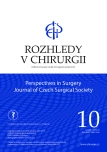Pulmonary arteriovenous malformation managed by VATS lobectomy
Authors:
I. Hanke 1; L. Maršík 1; V. Chovanec 2; M. Slanina 2; V. Koblížek 3
Authors‘ workplace:
Kardiochirurgická klinika Lékařské fakulty Univerzity Karlovy v Hradci Králové a Fakultní nemocnice Hradec Králové
1; Radiologická klinika Lékařské fakulty Univerzity Karlovy v Hradci Králové a Fakultní nemocnice Hradec Králové
2; Plicní klinika Lékařské fakulty Univerzity Karlovy v Hradci Králové a Fakultní nemocnice Hradec Králové
3
Published in:
Rozhl. Chir., 2020, roč. 99, č. 10, s. 467-471.
Category:
Case Report
Overview
Pulmonary arteriovenous malformation (PAVM) is formed by abnormal connections between pulmonary arteries and veins that bypass the pulmonary capillaries and transport deoxygenated blood through pulmonary veins to the left heart. This causes insufficient oxygenation of blood in the lungs. This condition remains symptomless for a long period of time. The most common symptoms include shortness of breath on exertion, nosebleeds, increased fatigue and a gradual development of cyanosis. Paradoxical embolism in the brain is a serious complication; it can present with a stroke or a brain abscess. Treatment of the disease consists of embolization of the pathological vascular connections, surgical resection of the affected pulmonary parenchyma and management of concomitant manifestations of the disease. PAVM in most common cases arises as a result of an autosomal dominant hereditary disorder referred to as hereditary hemorrhagic telangiectasia.
Case report: In our communication, we document the diagnostic and therapeutic management in a young patient diagnosed with PAVM after falling off his bicycle. Based on comprehensive assessments, AV malformations with a 40% shunt of the pulmonary circulation were detected. An angiographic procedure was not an appropriate option considering the type and extent of the condition. Therefore, video-assisted thoracic resection of the affected pulmonary lobe was indicated.
Conclusion: PAVM is a rare finding. PAVM should be ruled out in all patients with hereditary hemorrhagic telangiectasia (HHT) signs in the oral cavity. Contrast sonography of the heart and contract CT of the chest are the methods of choice for the diagnosis. Conservative or pharmacological treatment fails to improve the patient’s status. The condition is usually managed by embolization. Cases where PAVM is rather extensive or diffuse, where endovascular management would be inappropriate, can be well managed using endoscopic resection adequate to the extent of the condition.
Sources
- Churton T. Multiple aneurysm of pulmonary artery. Br Med J. (Clin Res Ed). 1897;1 : 1223.
- Shovlin CL. Pulmonary arteriovenous malformations. Am J Respir Crit Care Med. 2014;190(11):1217−1228.
- Love BA. Pulmonary arteriovenous fistulae. Medscape Reference 2015. http://emedicine.medscape.com/article/900681-overview.
- Pulmonary arteriovenous fistula. MedlinePlus. 2014; https://www.nlm.nih.gov/medlineplus/ency/article/001090.htm.
- Porstmann W. Therapeutic embolization of arteriovenous pulmonary fistula by catheter technique. In: Kelop O, editor. Current concepts in pediatric radiology. Berlin, Springer 1977 : 23−31.
- Trakal L, Malý P, Marušincová I, et al. Plicní arteriovenózní malformace jako vzácná příčina ischemické cévní mozkové příhody. Ces Slov Neurol N. 2019;82(5): 571−573.
- Adla T, Pádr R, Polovinčák M, et al. Plicní arteriovenózní malformace Ces radiol. 2019; 73 (1):62.
- Bakhos CT, Wang SC, Rosen JM. Contemporary role of minimally invasive thoracic surgery in the management of pulmonary arteriovenous malformations: report of two cases and review of the literature. J Thorac Dis. 2016;8(1):195−197.
- Meek ME, Meek JC, Beheshti MV. Management of pulmonary arteriovenous malformations. Semin Intervent Radiol. 2011;28(1):24–31. doi: 10.1055/s-0031-1273937.
- Krajina A, Koblizek V, Keller FS. Endovaskulární léčba plicních arteriovenózních zkratů. In: Krajina A, Peregrin JH. Intervenční radiologie – miniinvazivní terapie. Hradec Králové 2005 : 535−541.
- Liu CH W, Bhatia A, Buzon-Tan A, et al. Weeding out the problem: The impact of preoperative cannabinoid use on pain in the perioperative period. Anesth Analg. 2019;129 : 874–81.
Labels
Surgery Orthopaedics Trauma surgeryArticle was published in
Perspectives in Surgery

2020 Issue 10
Most read in this issue
- Postoperative chylothorax − review
- Hyperthermic intraoperative intrapleural chemotherapy and surgical cytoreduction as part of multimodal treatment of malignant pleural mesothelioma – case report M. Szkorupa1, D. Klos1, J. Chudacek1, J. Hanuliak1, M. Stasek1, O. Fischer2, R. Lemstrova3
- Malignancy after lung transplantation
- Role of extracorporeal life support in thoracic surgery
